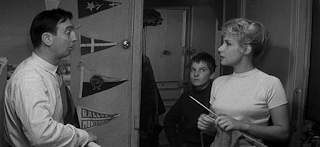The Road Home was the simplest yet most elegant love story I have ever seen. It was bursting with symbolism as each object in the film played an intricate role in the love story between Di and the teacher. The weaving in the film served as a symbol. It was remembrance of the husband, it stood for his memory. Di rushed to the weaving device when she met him, and it was her serenity and comfort zone when he passed. It served as a symbol to honor his memory. An obvious symbol in the film was the color red, which as we learned from the class presentation, stands for happiness and good luck. In the GIF below (obsessed with making these now), we see the red scarf partnered with the pink coat. These articles of clothing together symbolize her love and happiness for and from the teacher. I noticed the yellow color of the leaves, which produces a warming effect. The color yellow also symbolizes joy and energy. These yellow leaves express the joy the teacher brings to Di as she rushes eagerly to catch a glimpse of him. The use of color is also evident in the opening scene. The white and black coloring is the perfect symbol of what emotions are occurring. The mother is mourning the loss of her husband, and white symbolizes this mourning. Black also serves as a color to express black. Another beautiful symbol is the blue and white crafted bowl. It acts as a symbol for Di's heart. She gives it to the teacher in the food she makes, and it breaks when he has to leave. However, her broke heart and the bowl are repaired when he finally returns. Lastly, and maybe the largest symbol of all, the road. It stood for their journey to love and each other. Leaving me with the lesson that love will always find a way home. <3
Tuesday, September 29, 2015
Tuesday, September 22, 2015
Interesting Camera Movement: Tracking
Tuesday, September 15, 2015
Visual Style: 400 Blows
400 Blows was packed with numerous examples of visual style. I loved the aspect of deep focus in this film. It did not force the viewer to look at a specific character, but rather the picture as a whole, and all the characters in the scene. The view of children in this movie is complex. They are presented as vulnerable, yet strong. In many of the close-up shots we see the boy's vulnerability, but in other scenes we can see the determination and strength on his face. A sad, but critical close-up shot is when the boys parents are arguing. He is seen in his bed, and this close-up makes the viewer feel empathetic for the boy's unstable home life. The opening scene had great visual style, with the high-angle as we go through the streets. It is tracking and it feels like we the viewer is on a walk or drive. As we continue to the Eiffel Tower in the opening scene we are presented extreme long shots, that eventually become long shots. This is to indicate we are also headed to a destination. I picked up on many medium shots in the film as well. Like the example pictured above, medium shots were important in this film to display the expressions between the family. The mom usually had an annoyed expression, while the father was either goofing around or upset. Usually while this interaction was occurring the boy seemed emotionless. It conveyed the feeling that he really was not clear how he felt about his parents. I also noticed some distinct scene changes, with dissolves and fades. I loved the tracking as the boys move within the streets, along with the upbeat music. It conveys the trouble to the viewer that the boys are about to cause. My favorite scene in the movie is the high-angle tracking shot of the school boys running behind the teacher. The angle makes the scene, and we feel like we are in on the joke. It is comedic watching from above. It was great to not have the angle of the street goers in the scene as we watch the schoolboys dart off.
Interesting Camera Shot: The Hunger Games
This is an example of a close-up. I love the Hunger Games, but also love analyzing this shot. In the close-up you can see the expressionless faces of Peeta and Katniss. It allows the viewer to feel their complete shock and surprise in this scene. They simply don't know what to think. I also love the close-up to look at the difference between the high society Capitol looks and the District plain, uniform, low class looks. There is so much contrast depicted in just this one close-up that I thought it was an interesting and perfect camera angle to use!
Subscribe to:
Comments (Atom)



